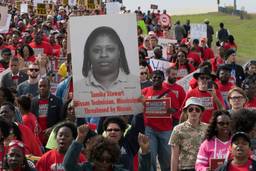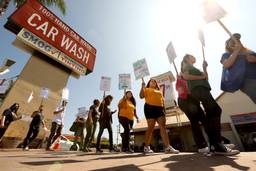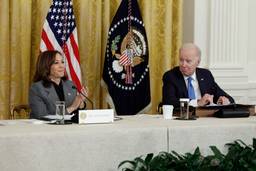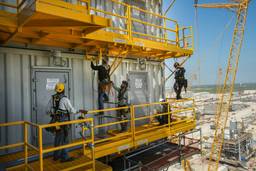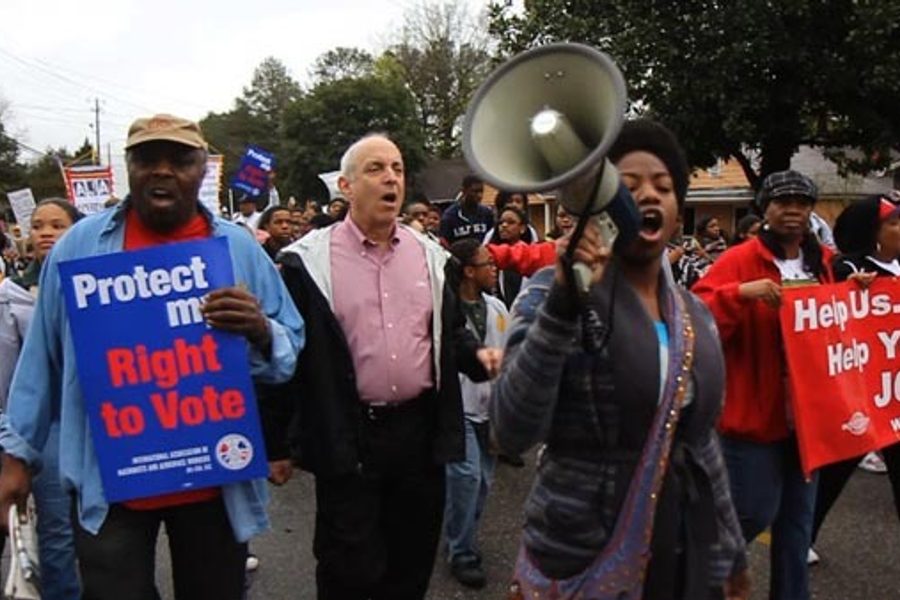
ORLANDO — Last week union leaders, including AFL-CIO executive vice-president Arlene Holt Baker and Communications Workers of America president Larry Cohen, joined in a re-enactment of the famous 1965 Selma to Montgomery Voting Rights Act march. It signaled not only tribute to a historic movement but also the launch of organized labor’s commitment to fighting with its allies against contemporary Republican initiatives to suppress voting by disproportionately pro-Democratic groups of voters (as well as immigration reform).
“We clearly see an effort to take away voice and vote, and it’s selective who they want to take voice and vote from,” Baker said Wednesday at a meeting in Orlando of the federation’s executive council. First, Republicans have tried to take away, in law or practice, workers’ rights to bargain with their employer or even to form a union, she said. Then they focused on a wide variety of laws to make voting more difficult for young people, people of color, and the poor.
“If you can suppress the voice and vote of that grouping of people,” Baker said. “You’ve been able to destroy our democracy.”
The AFL-CIO also called for overturning the Supreme Court’s Citizens United ruling that allows corporations unlimited independent spending on politics and has spawned the rise of nominally independent Super-PACs. The union federation also called for reforms to keep corporations out of politics and end their treatment as legal persons.
The voter groups targeted under the new state laws helped Obama and Democrats win in 2008, but as a result of the Republican victories in 2010, Republican-dominated state legislatures in all but three states introduced new laws requiring voter identification — even though George W. Bush’s Justice Department found only 86 cases of fraud nationwide, an incidence described as being as likely as getting hit by lightning. The templates for the bills came from the right-wing American Legislative Exchange Council, whose co-founder nearly three decades ago declared, “I don’t want everyone to vote.”
A dozen states enacted new “voter protection” provisions, from requiring photo IDs to eliminating same-day registration and voting, restricting early voting, and establishing new hurdles to registration. For example, Florida requires volunteer registrars to turn in names within two days or face stiff fines (such as those imposed on a teacher who registered his students).
That prompted the venerable League of Women Voters to abandon its registration work. Critics, with statistical justification, see the bills as “voter suppression.” New York University’s Brennan Center calculates that the laws, if they withstand lawsuits and Obama administration interentions under the Voting Rights Act, could disenfranchise five million voters and tip the electoral scales against Obama. One early victim of Tennessee’s new identification was a 96-year old African-American woman, Dorothy Cooper, who has voted in every election for 70 years.
At the announcement of the AFL-CIO’s new effort against such disenfranchisement, political director Michael Podhorzer said that “voter protection is an absolute core part of what we have to do to win in 2012 and beyond….The AFL-CIO has always taken voter protection seriously, but it’s fair to say that we are taking it seriously by several orders of magnitude more in this election cycle.”
Many of the projected 400,000 grassroots political activists the federation’s unions hope to recruit — up from 250,000 four years ago — will work to educate voters targeted for suppression about their rights and assist them in registering before the election, then watch polling places and monitor the right on both administrative preparations as well as on election day. Unions are working on the campaign with civil rights and other groups, including the NAACP, La Raza, and Center for Community Change.
Cohen sees the voter rights fight as linked to labor’s immediate struggles as part of a broad movement to fight for greater democracy: “For our union, CWA, there’s no path to economic justice, no path to greater equality, no path to restore collective bargaining rights that doesn’t start with the democracy movement,” from Madison to Tunisia, fom the Civil Rights movement of the ’60s to the fight against voter suppression this fall.
SPECIAL DEAL: Subscribe to our award-winning print magazine, a publication Bernie Sanders calls "unapologetically on the side of social and economic justice," for just $1 an issue! That means you'll get 10 issues a year for $9.95.
David Moberg, a former senior editor of In These Times, was on staff with the magazine from when it began publishing in 1976 until his passing in July 2022. Before joining In These Times, he completed his work for a Ph.D. in anthropology at the University of Chicago and worked for Newsweek. He received fellowships from the John D. and Catherine T. MacArthur Foundation and the Nation Institute for research on the new global economy.



